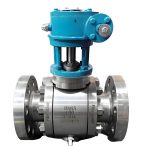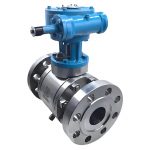TIANYU 304 Stainless Steel Flanged Floating Ball Valve: Corrosion-Resistant Full-Port Flow Control Solution for Industrial, Sanitary, and Municipal Media with Leak-Tight Sealing
I. Product Overview

II. Key Attribute Specifications
A. Dimensional & Pressure-Temperature Parameters
- Port Size: Ranging from ½in to 16in (DN15 to DN400), covering small-scale instrumentation lines to large-diameter industrial pipelines. The full-port design ensures the valve’s internal bore matches the pipeline diameter, minimizing pressure drop and maximizing flow efficiency—critical for high-throughput applications like water distribution or chemical transfer.
- Pressure Rating: PN10 to PN25 (CLASS 150 to CLASS 300), aligning with low-to-medium industrial pressure requirements. This versatility suits both general service (e.g., municipal water systems) and moderate-pressure processes (e.g., steam auxiliary lines in power plants).
- Temperature Range: -20℃ to 200℃, enabled by 304 stainless steel’s thermal stability and compatible seal materials (PTFE, EPDM, FKM). The range accommodates cryogenic fluids, ambient media, and moderately heated process streams, from chilled water to hot oil.
B. Material Composition
- Valve Body & Bonnet: 304 stainless steel (ASTM A351 CF8), containing 18–20% chromium and 8–10.5% nickel. This alloy offers excellent corrosion resistance to water, steam, mild acids, alkalis, and atmospheric conditions—making it ideal for coastal, humid, or chemically exposed environments.
- Ball & Seat: Solid 304 stainless steel ball with precision-ground surface finish (Ra ≤0.2μm) for uniform seal contact. Seat materials include PTFE (polytetrafluoroethylene) for chemical inertness, EPDM (ethylene propylene diene monomer) for general media, and FKM (fluorocarbon rubber) for oil/fuel compatibility.
- Valve Stem: 304 or 17-4PH stainless steel, featuring an anti-blowout design to prevent stem ejection under pressure. The material resists corrosion and mechanical wear, with a polished surface (Ra ≤0.4μm) to reduce friction during operation.
- Gaskets & Fasteners: Spiral-wound gaskets (stainless steel with graphite filler) for body-bonnet sealing, paired with 304 stainless steel fasteners (ASTM A240) to maintain corrosion resistance throughout the assembly.
C. Connection & Operational Features
- Connection Type: Flanged ends (ANSI B16.5, Raised Face/RF) as standard, with optional JIS or GB flange standards for regional compatibility. The RF flange design ensures secure gasket seating, even under vibration or pressure fluctuations, while bolt-through installation simplifies alignment and retrofitting.
- Operation Mode: Manual (handwheel or worm gear) as standard, with optional pneumatic or electric actuation for automated control. Handwheel operation suits low-frequency use, while worm gear operators reduce torque for large-diameter valves (DN200+). Pneumatic/electric actuators support remote monitoring and integration with SCADA/DCS systems, ideal for high-cycle or safety-critical applications.
- Safety & Control Features: Optional anti-static device to discharge static electricity in flammable media; lockable handwheel to prevent unauthorized operation; position feedback (limit switches or 4–20mA signals) for process automation.
D. Certifications & Compliance
- Industry Standards: API 608 (floating ball valves for industrial service), ASME B16.34 (valves—flanged, threaded, and welding end), ASME B16.5 (pipe flanges), API 598 (valve testing and inspection), ISO 5208.
- Material Certifications: ASTM A351 (CF8 304 stainless steel), ASTM A240 (stainless steel fasteners), FDA (optional for food-grade applications).
- Regional Approvals: CE, ATEX (optional for hazardous environments), WRAS (optional for potable water), ISO 9001.
III. Feature Description
A. 304 Stainless Steel Construction: Corrosion Resistance for Versatile Use
B. Floating Ball Design: Self-Enhancing Leak-Tight Sealing
C. Full-Port Configuration: Flow Efficiency & Energy Savings
D. Flanged Connection: Installation Flexibility & Reliability
- Secure Sealing: The RF flange paired with spiral-wound gaskets creates a leak-tight joint that resists vibration, thermal cycling, and pressure fluctuations. In a chemical plant’s reactor feed line, this prevented fugitive emissions of hazardous chemicals, meeting environmental regulations (e.g., EPA, EU REACH).
- Easy Maintenance: Flanged valves can be disassembled without cutting pipelines, simplifying seat replacement, stem packing adjustment, or actuator maintenance. This reduces downtime by 50% compared to welded valves, critical for continuous-process industries like power generation.
- Global Compatibility: ANSI B16.5 compliance ensures compatibility with standard pipelines from other manufacturers, making the valve suitable for multi-vendor projects and international installations.
E. Versatile Operation & Seal Options
- Manual Operation: Handwheel operators suit low-frequency use (e.g., emergency isolation), while worm gear operators reduce torque for large valves (DN200+), enabling single-person operation.
- Automated Actuation: Pneumatic (double-acting or spring-return) and electric actuators support remote control and process automation. Spring-return pneumatic actuators provide fail-safe operation (auto-close/auto-open) during air supply loss, a critical safety feature in oil & gas or chemical facilities.
- Seal Compatibility: PTFE seals suit aggressive chemicals (acids, alkalis, solvents), EPDM seals for water and steam, and FKM seals for oil and fuel. This versatility allows the valve to handle media ranging from potable water to industrial solvents, eliminating the need for multiple valve types.

IV. Manufacturing Processes
A. Material Inspection & Preparation
- 304 Stainless Steel Verification: Raw material billets undergo spectral analysis to confirm chemical composition (Cr: 18–20%, Ni: 8–10.5%) and ultrasonic testing to detect internal defects (porosity, cracks). Mechanical testing (tensile strength ≥515MPa, yield strength ≥205MPa) ensures compliance with ASTM A351.
- Seal Material Testing: PTFE/EPDM/FKM seals are tested for compression set, tensile strength, and chemical resistance at operational temperatures (-20℃~200℃) to ensure long-term performance. FDA-compliant seals undergo additional purity testing for food/pharmaceutical applications.
B. Valve Body & Bonnet Fabrication
- Casting: The body and bonnet are produced via investment casting for 304 stainless steel, ensuring dimensional accuracy and a smooth internal surface. Castings are heat-treated (solution annealing at 1010–1120℃, water-quenched) to restore corrosion resistance and relieve internal stresses.
- Machining: CNC turning and milling centers precision-machine the body, bonnet, and flange faces. Flange dimensions are machined to ANSI B16.5 standards, with flatness tolerance ≤0.05mm/m and surface finish Ra ≤3.2μm for proper gasket seating. The body’s internal seat pocket is machined to exact tolerances (±0.02mm) to ensure uniform seat contact.
C. Ball & Stem Manufacturing
- Ball Production: Solid 304 stainless steel blanks are turned, ground, and lapped to achieve a mirror-like surface finish (Ra ≤0.2μm). The ball’s diameter is precision-controlled to ensure a tight fit within the seat, with a tolerance of ±0.01mm.
- Stem Machining: Valves stems are CNC-machined from 304 or 17-4PH stainless steel, with a polished surface to reduce friction. The anti-blowout feature is integrated during machining, ensuring the stem cannot be ejected under pressure—meeting API 608 safety requirements.
D. Assembly & Quality Testing
- Component Assembly: The ball, stem, seat, and packing are assembled into the body-bonnet assembly. The seat is press-fitted into the body pocket, with spring loading to compensate for thermal expansion and wear. The bonnet is secured with high-strength bolts, compressing the spiral-wound gasket to form a leak-tight seal.
- Hydrostatic Testing: The valve undergoes shell testing at 1.5× rated pressure and seat testing at 1.1× rated pressure, with a 30-minute hold time. No leakage, sweating, or deformation is allowed. For gas service, pneumatic testing (0.6MPa) is performed to confirm bubble-tight sealing.
- Operational Testing: The valve is cycled 100 times to verify smooth operation, torque consistency, and seal integrity. Manual operators are tested for torque requirements (≤30N·m for DN50), while automated actuators are calibrated for response time (10–30 seconds) and position accuracy.
- Non-Destructive Testing (NDT): Critical welds (if applicable) undergo liquid penetrant testing (PT) to detect surface cracks; cast components are inspected via magnetic particle testing (MPI) for surface defects.
E. Final Inspection & Documentation
- Visual Inspection: The valve is inspected for surface finish, proper marking (port size, pressure rating, material, serial number), and compliance with ASME B16.34.
- Documentation: Each valve is accompanied by a Material Test Report (MTR) for 304 stainless steel, hydrostatic test report, and compliance certificates (API 608, ISO 9001). For sanitary applications, FDA certification and material purity reports are provided.
V. Product Advantages
A. Exceptional Corrosion Resistance
B. Bubble-Tight Sealing Reliability
C. Flow Efficiency & Energy Savings
D. Easy Installation & Maintenance
E. Versatile Application Compatibility
F. Cost-Effective Performance
VI. Product Applications
A. Chemical Processing
- Mild Chemical Transfer: ½in–12in (DN15–DN300) valves with PTFE seals handle acetic acid, sodium hydroxide, and ethanol. 304 stainless steel resists chemical corrosion, while the floating ball design ensures leak-tight performance.
- Solvent Recovery Systems: 2in–8in (DN50–DN200) valves regulate flow of organic solvents (methanol, acetone) in distillation systems. The full-port design minimizes pressure drop, improving process efficiency.
B. Water & Wastewater Treatment
- Municipal Water Distribution: 4in–16in (DN100–DN400) valves control flow in potable water mains. 304 stainless steel ensures water quality by resisting corrosion, while the flanged connection simplifies integration with existing pipelines.
- Wastewater Treatment: 2in–10in (DN50–DN250) valves handle treated effluent and process water. EPDM seals resist chlorine and cleaning agents, ensuring long-term reliability.
C. Food & Beverage Industry
- Process Water Systems: ½in–6in (DN15–DN150) valves with FDA-compliant EPDM/PTFE seals control flow of potable water and cleaning solutions. 304 stainless steel’s smooth surface is easy to clean, meeting hygiene standards (e.g., FDA, EU 10/2011).
- Beverage Production: 1in–8in (DN25–DN200) valves regulate flow of juices, carbonated drinks, and dairy products. The leak-tight seal prevents product contamination, ensuring compliance with food safety regulations.
D. Oil & Gas Industry
- Refined Products Pipelines: 4in–16in (DN100–DN400) valves with FKM seals control flow of gasoline, diesel, and lubricants. 304 stainless steel resists hydrocarbon corrosion, while the flanged connection ensures secure sealing in high-flow lines.
- Gas Distribution: 1in–6in (DN25–DN150) valves manage natural gas or propane flow in industrial and commercial systems. The optional anti-static device mitigates explosion risks in flammable media.
E. Power Generation
- Auxiliary Steam Lines: 2in–10in (DN50–DN250) valves regulate low-pressure steam flow in thermal power plants. 304 stainless steel withstands moderate temperatures, while the floating ball design ensures reliable sealing.
- Cooling Water Systems: 6in–16in (DN150–DN400) valves control flow of cooling water in turbines and condensers. The full-port design minimizes pressure drop, reducing pump energy consumption.
F. General Industrial Applications
- Manufacturing Plants: ½in–8in (DN15–DN200) valves regulate flow of process fluids, lubricants, and cooling water in automotive, electronics, and machinery manufacturing. The versatile seal options adapt to diverse media requirements.
- Marine & Offshore: 2in–12in (DN50–DN300) valves handle seawater, ballast water, and fuel in ships and offshore platforms. 304 stainless steel resists saltwater corrosion, ensuring long service life in marine environments.
VII. Customization
RELATED
-

API ANSI 2in-16in DN50-DN400 PN10 PN16 CF8M Pneumatic Flanged Floating Ball Valve
TIANYU CF8M Pneumatic Flanged Floating Ball Valve: 2in-16in (DN50-DN400) PN10-PN16 API/ANSI Class Corrosion-Resistant Flow Control Solution for Indust…
BALL VALVE 11/01/2025 -

Large-Diameter DN1400 CLASS150 WCB SS Triple Eccentric Metal-Sealed Hard Seal Butterfly Valve
TIANYU DN1400 (56″) CLASS 150 WCB Hard Seal Butterfly Valve: Triple Eccentric Metal-Sealed Flanged Valve for Large-Diameter Industrial Media wit…
BUTTERFLY VALVE 10/30/2025 -

PN16 Stainless Steel Floating Ball Valve: Full Port 2PC Flange-Connected Valve with Fire-Safe & Anti-Static SS Ball Valve
TIANYU Stainless Steel Floating Ball Valve: Full Port 2PC Flange-Connected Valve with Fire-Safe & Anti-Static Design for Oil, Gas, and Industrial …
BALL VALVE 10/29/2025 -

High-Performance DN80 Class 150 WCB Soft-Sealed Lug-Type Double Eccentric Butterfly Valve
TIANYU 3” Class 150 WCB lug-type double eccentric butterfly valve is a technologically advanced flow control device engineered to address the challeng…
BUTTERFLY VALVE 10/25/2025 -

DN125 PN16 CF8M Stainless Steel Lug-Type Butterfly Valve with PTFE Lining Concentric Line Butterfly Valves
TIANYU DN125 PN16 CF8M stainless steel lug-type butterfly valve is a precision-engineered flow control device designed to address the challenges of ha…
BUTTERFLY VALVE 10/25/2025 -

API6D ASME DN100 PN16 CF8/316L stainless steel Electric Actuator Motorized Floating Ball Valve For Normal Temperature Water
TIANYU DN100 PN16 CF8 Electric Actuator Motorized Ball Valve: Stainless Steel Flanged Full-Port Flow Control Solution for Industrial Media with Automa…
BALL VALVE 10/24/2025







